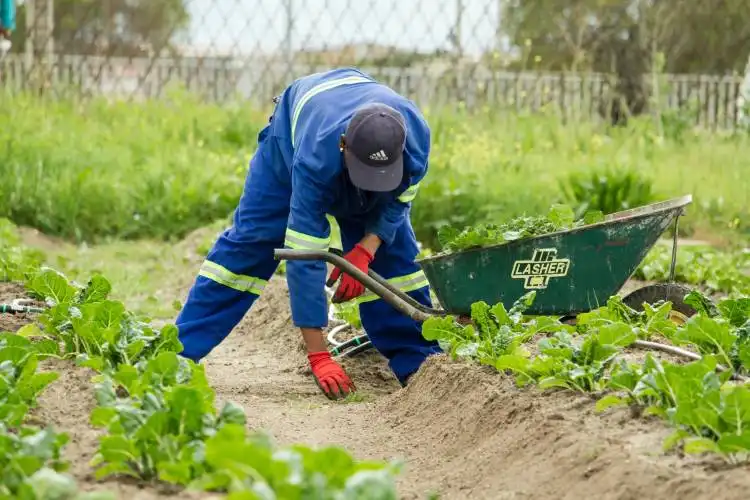Start a Hot Tub Garden
Create a Paradise of Profit with a Hot Tub Garden Business!
| Updated


HOT TUB GARDEN
Unwind your entrepreneurial spirit into the calm and soothing waters of a Hot Tub Garden business! Imagine crafting a lush botanical haven, punctuated with luxurious, bubbling hot tubs; it's an absolute relaxation package sold as a high-end experience. Your business would be leasing private hot-tub spaces surrounded by serene gardens to individuals or groups seeking an exclusive getaway. Warm their bodies and their hearts in your idyllic retreat all while bagging a crisp, cool profit!
Jump to Business Plan
RELATED BUSINESS IDEAS
Browse ALL Home Improvement & Repair Solutions Business Ideas
Discover Your Perfect Domain
Unlock the door to your online success with our hand-picked selection of premium domain names. Whether you're starting a new venture or rebranding an existing one, the right domain can set the tone for your digital presence. Browse through our curated list, each with its unique potential to enhance your brand's visibility and credibility.
HOT TUB GARDEN MINI BUSINESS PLAN
This a quick reality check to help you identify the strengths and weaknesses of your business concept before you dive in.
Expected Percent Margin:
- Gross Margin: 50-70%
- Net Profit Margin: 20-30%
Earnings Expectations:
- Daily Earnings: $400 - $1000
- Weekly Earnings: $2800 - $7000
- Monthly Earnings: $12,000 - $30,000
- Annual Earnings: $144,000 - $360,000
Actions to Hit Those Numbers:
Initial Set-Up:
- Hot Tub Investment: Expect to invest around $10,000 - $20,000 per hot tub (including installation and setup costs).
- Garden Set-up: A budget of $5000 - $10,000 is reasonable considering landscaping, gardening equipment and plants.
Ongoing Operations:
- Daily Maintenance: Budget for daily cleaning and regular maintenance for each hot tub which can be in the range of $500 - $1000 per month.
- Utility Bills: Expect higher water and electricity costs. Depending on usage, this could range from $1000 to $2000.
Marketing and Customer Acquisition:
- Social Media: Post 3-4 times a week on platforms popular with your target demographic.
- Local Advertising: Budget at least $500 a month for local newspaper ads or community sponsorships.
Sales and Customer Experience:
- Staffing: Employ staff for reception, cleaning and maintenance.
- Experiences: Offer different types of experiences like relaxation packages, couples packages, and party packages.
Cost Control:
- Rent: If you don't own a suitable location, consider the cost of monthly rent.
- Insurance: Make sure you've budgeted for comprehensive public liability insurance.
Business Operations:
- Opening Hours: Consider running in two to three blocks of time each day.
- Transaction Volume: Depending on the number of tubs and duration of use, aim for 8-16 transactions per day.
These are generalized estimations and can significantly vary depending on location, competition, economic conditions, and individual business strategy. Always consult with a local business advisor or financial consultant for personalized advice and local regulations.
NOT WHAT YOU HAD IN MIND? Here are more ideas



Browse ALL Home Improvement & Repair Solutions Business Ideas
Grab Your Business Website Name
Before you get caught up in the whirlwind of setting up your business, invest in a domain name. It's a small but significant step that lays the foundation for your brand and makes it easier for customers to find and trust you. Just like you wouldn't build a house without securing the land first, don't build a business without securing your domain name.
"Why? Can't that wait?" Here's why it shouldn't
Step 1: Determine if the Business is Right Endeavor
Breakdown of Startup Expenses
Before starting a hot tub garden business, it is important to understand the startup costs associated with the endeavor. These costs can include the purchase of the hot tub, the cost of installation, the cost of any necessary permits, and the cost of any other necessary supplies. Additionally, it is important to consider the cost of marketing and advertising, as well as the cost of any necessary labor. It is important to understand the total cost of starting the business before making any commitments.
Breakdown of Ongoing Expenses
Once the business is up and running, there are a number of ongoing expenses that must be taken into account. These can include the cost of supplies, such as chemicals and filters, as well as the cost of any necessary labor. Additionally, it is important to consider the cost of marketing and advertising, as well as any necessary permits or licenses. It is important to understand the total cost of running the business before making any commitments.
Examples of Ways to Make Money
Once the business is up and running, there are a number of ways to make money. These can include charging for hot tub rentals, selling hot tub accessories, and offering hot tub maintenance services. Additionally, it is possible to offer hot tub parties, as well as hot tub classes or workshops. It is important to consider all of these options before deciding on a pricing structure.
Step 2: Name the Business
Choosing a name for your hot tub garden business is an important step in the process. It should be something that reflects the services you provide and is easy for customers to remember. It should also be unique and memorable. When choosing a name, consider the following tips:
Brainstorm. Make a list of words that relate to your business and then combine them to create potential names.
Research. Check to make sure the name you choose is not already taken by another business.
Keep it simple. Avoid overly long or complicated names.
Ask for feedback. Ask friends and family for their opinion on the name you choose.
Consider the future. Think about how the name will look on business cards, websites, and other marketing materials.
Step 3: Create a Business Plan
Creating a business plan is an essential step for any business, and a hot tub garden is no exception. A business plan should include a description of the business, a market analysis, an organizational structure, a marketing plan, and a financial plan. The description of the business should include the purpose and goals of the business, the products and services offered, and the competitive advantage of the business. The market analysis should include an analysis of the target market, the competition, and the industry trends. The organizational structure should include the roles and responsibilities of the owners, employees, and any other personnel involved in the business. The marketing plan should include the strategies used to promote the business, the pricing of products and services, and the methods used to reach the target market. The financial plan should include a detailed breakdown of the startup and ongoing expenses, as well as the projected revenue and profits of the business.
Tips for Creating a Business Plan
Creating a business plan can be a daunting task, but there are a few tips to help make the process easier. First, research the industry and the target market to ensure that the business plan is accurate and up-to-date. Second, use a business plan template to ensure that all the necessary components are included. Third, consult with a professional to ensure that the business plan is comprehensive and accurate. Finally, review the business plan regularly to ensure that it is up-to-date and that the goals of the business are being met.
Step 4: Obtain Necessary Licenses and Permits
Before obtaining any licenses or permits, it is important to research the local requirements. Depending on the location, there may be different regulations and requirements that must be met in order to legally operate a hot tub garden. For example, some areas may require a special permit to operate a business that involves the use of water. Additionally, some areas may require a business license in order to operate. It is important to research the local requirements and make sure that all necessary licenses and permits are obtained before opening the business.
Contact Local Government
Once the necessary licenses and permits have been identified, the next step is to contact the local government to obtain them. This can be done by visiting the local government office or by contacting them via phone or email. It is important to make sure that all necessary paperwork is filled out correctly and that all fees are paid in full. Additionally, it is important to keep all paperwork and licenses in a safe place, as they may be needed in the future.
Follow Local Regulations
Once all necessary licenses and permits have been obtained, it is important to make sure that all local regulations are followed. This includes making sure that all safety regulations are met and that any necessary inspections are completed. Additionally, it is important to make sure that any necessary taxes are paid on time and that all necessary paperwork is filed correctly. Following local regulations is essential in order to ensure that the business is operating legally.
Step 5: Find a Suitable Location
Finding the right location for a hot tub garden is essential for success. When considering a location, it is important to think about the size of the area, the amount of foot traffic, and the type of customers that will be attracted to the business. It is also important to consider the zoning laws in the area, as well as any permits or licenses that may be required to operate a business in that location.
Research Local Regulations
Once a potential location has been identified, it is important to research the local regulations and zoning laws to ensure that the business is in compliance. This includes researching any permits or licenses that may be required to operate a business in that location. Additionally, it is important to research any restrictions or limitations that may be in place for the type of business being operated.
Secure the Location
Once the location has been identified and the necessary research has been done, it is time to secure the location. This may involve signing a lease, purchasing the property, or entering into a partnership with the owner. It is important to ensure that all legal documents are in order before signing any agreements.
Prepare the Location
Once the location has been secured, it is time to prepare the area for the hot tub garden. This may involve clearing the area, installing utilities, and making any necessary repairs or renovations. It is important to ensure that the area is safe and secure before opening the business. Additionally, it is important to ensure that the area is aesthetically pleasing and inviting to customers.
Step 6: Purchase Necessary Equipment
When starting a hot tub garden, there are several pieces of equipment that are necessary to get the business off the ground. These include a hot tub, a pump, a filter, a heater, and a cover. The hot tub should be large enough to accommodate the number of people expected to use it, and the pump and filter should be powerful enough to keep the water clean and circulating. The heater should be able to maintain a comfortable temperature, and the cover should be sturdy enough to keep out debris and pests.
Where to Buy
When purchasing the necessary equipment for a hot tub garden, it is important to shop around for the best prices. Many local stores will have a selection of hot tubs, pumps, filters, heaters, and covers, but it is also possible to purchase these items online. It is important to compare prices and read customer reviews to ensure that the equipment is of good quality and will last for many years. Additionally, it is important to consider any warranties that may be available.
Installation
Once the necessary equipment has been purchased, it is important to have it installed properly. Depending on the type of equipment purchased, it may be necessary to hire a professional to install it. Professional installation will ensure that the equipment is installed correctly and safely, and that it will last for many years. Additionally, it is important to follow the manufacturer's instructions for proper maintenance and care of the equipment.
Step 7: Hire Employees
When hiring employees for a hot tub garden business, it is important to consider the necessary skills and qualifications for the job. Depending on the size of the business, it may be necessary to hire a manager or other staff to help with the day-to-day operations. It is also important to consider the cost of hiring employees, including wages, benefits, and other associated costs. Additionally, it is important to consider the legal requirements for hiring employees, such as background checks and other paperwork.
Finding Employees
When it comes to finding employees, there are a few options. One option is to post job listings online or in local newspapers. This can be a great way to reach a wide range of potential employees. Additionally, networking with other businesses in the area can be a great way to find qualified employees. Additionally, word-of-mouth can be a great way to find employees, as people may know someone who is qualified for the job.
Interviews
Once potential employees have been identified, it is important to conduct interviews to determine if they are the right fit for the job. During the interview, it is important to ask questions that will help determine if the candidate has the necessary skills and qualifications for the job. Additionally, it is important to ask questions that will help determine if the candidate is a good fit for the company culture.
Onboarding
Once a candidate has been selected, it is important to have an onboarding process in place. This should include providing the employee with the necessary information about the job, such as job duties, expectations, and company policies. Additionally, it is important to provide the employee with the necessary training and resources to ensure they are successful in their role.
Step 8: Market the Business
When it comes to marketing a hot tub garden business, there are a variety of strategies that can be employed. Social media is a great way to get the word out about the business, as well as creating a website or blog. Additionally, creating a presence at local events and festivals is a great way to get the word out about the business. Finally, creating a referral program or offering discounts to customers who refer others is a great way to get more customers.
Tips for Effective Marketing
When marketing the business, it is important to focus on the unique aspects of the business and what sets it apart from the competition. Additionally, it is important to target the right audience and create content that resonates with them. Additionally, it is important to track the results of the marketing efforts to ensure that they are effective. Finally, it is important to be consistent with the marketing efforts and to stay up to date with the latest trends and technologies.
Step 9: Monitor Business Performance
The final step in starting a hot tub garden business is to monitor performance. To do this, it is important to track the business’s financial performance. This includes tracking income, expenses, and profits. It is also important to track customer feedback and satisfaction. This can be done through surveys, reviews, and other feedback methods. Additionally, tracking the number of customers and the amount of time they spend in the hot tub garden can provide valuable insights.
Adjusting Business Strategies
Once performance has been tracked, it is important to adjust business strategies as needed. This may include changing pricing, increasing marketing efforts, or adding new services. It is also important to adjust the hot tub garden’s layout and design to ensure it is meeting customer needs. Additionally, it is important to review the business’s policies and procedures to ensure they are up to date. Finally, it is important to review the business’s goals and objectives to ensure they are still relevant.
Evaluating Business Performance
Finally, it is important to evaluate the business’s performance on a regular basis. This includes reviewing the financial performance of the business, customer feedback, and the overall success of the business. It is also important to review the business’s goals and objectives to ensure they are still being met. Additionally, it is important to review the business’s policies and procedures to ensure they are still effective. By regularly evaluating the business’s performance, it is possible to identify areas for improvement and make necessary adjustments.
EXPLORE MORE CATEGORIES
Browse ALL Business Idea Categories
TAKE THE NEXT STEPS










